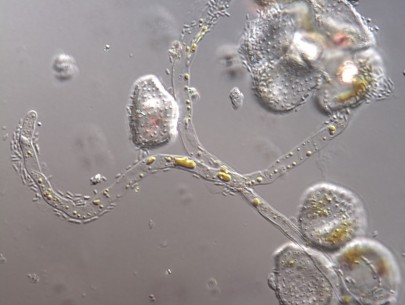Ground-breaking RNAi research driven by collaboration

Austropuccinia psidii germinated on PDMS discs. Image provided by the authors.
New Zealanders contributed to this research, which was recently published in the journal Molecular Plant Pathology, through the provision of artificial surfaces that allowed scientists to visualise how growth was interrupted.
The study outlines a new application of an existing technology called RNA interference (RNAi). RNAi refers to a conserved molecular mechanism where small pieces of double stranded RNA (dsRNA) shut down protein translation by binding to and degrading messenger RNAs that code for the proteins. An Australian team from The University of Queensland and Queensland Department of Agriculture and Fisheries designed dsRNA that could compromise myrtle rust’s ability to infect leaves.
While researchers were able to observe infection differences between dsRNA-treated and untreated leaves, it was unclear what the impact was on the infection architecture of the fungi at a microscopic level.
Grant Smith, Plant & Food Research plant pathologist and co-author on the paper, is a research leader within the Beyond Myrtle Rust (BMR) programme. He is working with Australian colleagues to understand the process of fungal spore germination.
“New Zealand researchers at the University of Canterbury have been looking at the germination of rust fungi on artificial surfaces,” says Grant. “I wondered if the materials they were developing would aid in understanding more fully gene expression during spore germination.”
Austropuccinia psidii, the fungus that causes myrtle rust, is a biotroph, meaning that it requires a living host to survive. However, the team found that polydimethylsiloxane (PDMS) discs treated with polyvinylpyrrolidone (PVP) could foster germination and growth of A. psidii spores. While these spores would eventually die without access to a living host, researchers thought that this medium might be able to deliver insight into patterns of early growth.
The University of Canterbury manufactured PDMS discs and sent them to collaborators in Queensland. The use of these discs in the RNAi experiment was a revelation.
“Alistair McTaggart, an author of the paper, was really excited because he could easily see fungal structures that are rarely seen,” says Grant.
Specifically, the Australian team was able to see that dsRNA treatments led to the withering of germ tubes (the “roots/shoots” of the germinating fungal spore), reduced germination rates and the loss of structures needed to infect a leaf’s surface (called infection pegs).
The study became the first of its kind to use PDMS discs to visualize the impact of dsRNA on the formation of rust fungi infection structures. This has only been possible due to strong collaborations between Australia and New Zealand in the myrtle rust space.
“Myrtle rust is a really destructive pathogen that both countries are trying to deal with,” says Grant. “I see the ongoing collaboration between Australia and New Zealand to fight this common enemy as one of the best examples of collaboration that I’ve ever been involved with.”
The production and initial assessment of the PDMS discs for A. psidii pathology studies was supported by the New Zealand Government MBIE Beyond Myrtle Rust program. The research resulting in the generation of the discs was led by Volker Nock and Ashley Garrill at the University of Canterbury with BMR PhD student Sarah Sale further advancing this work.
